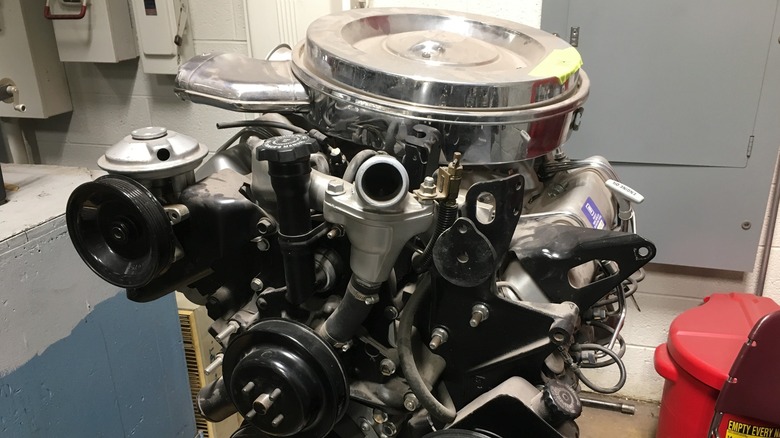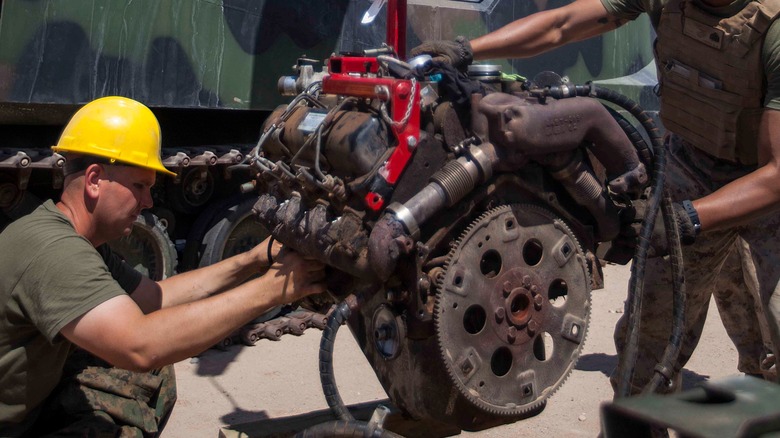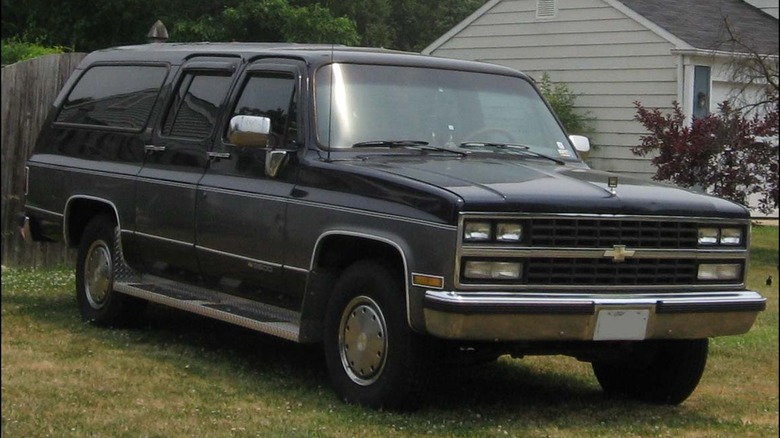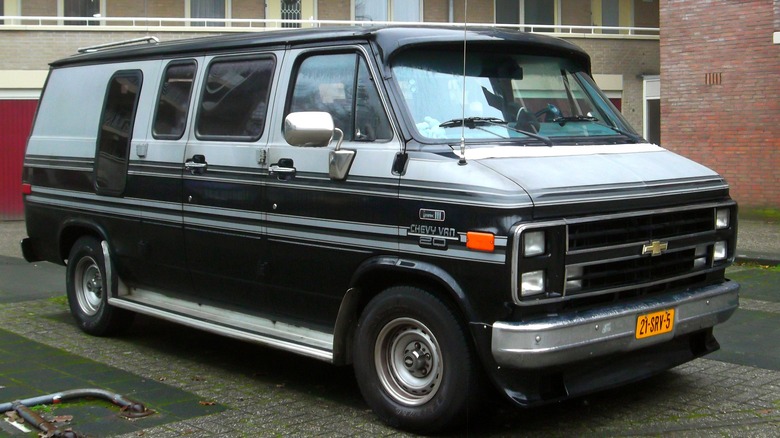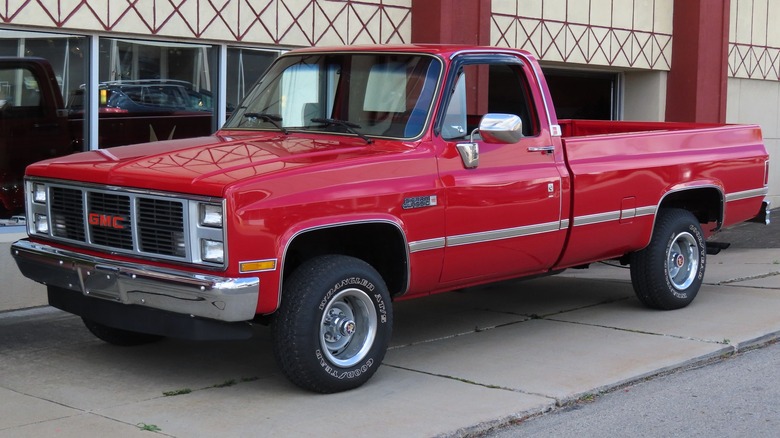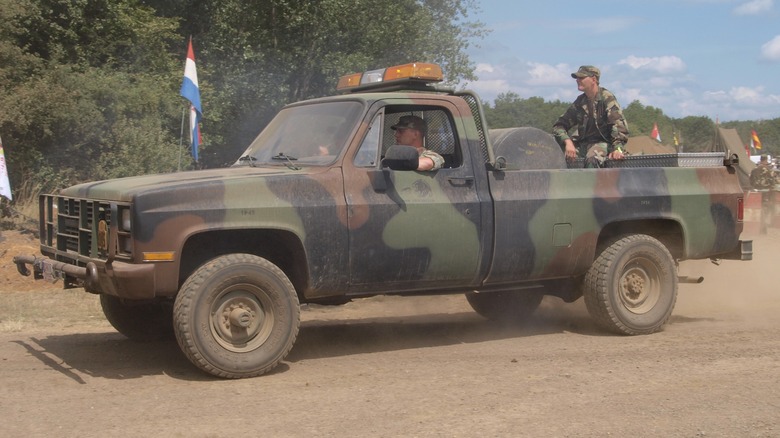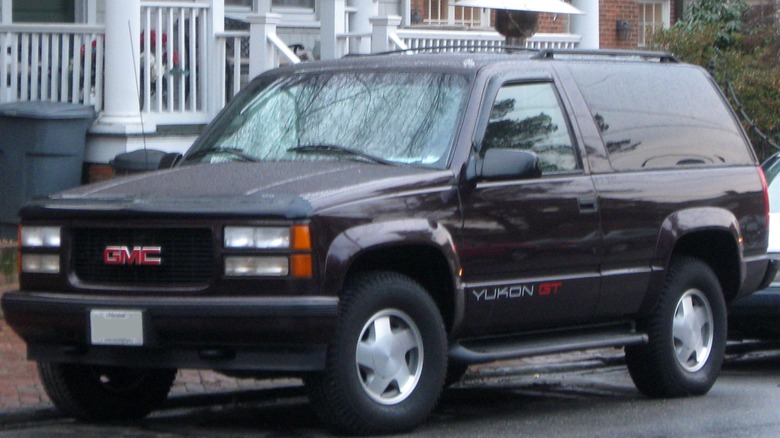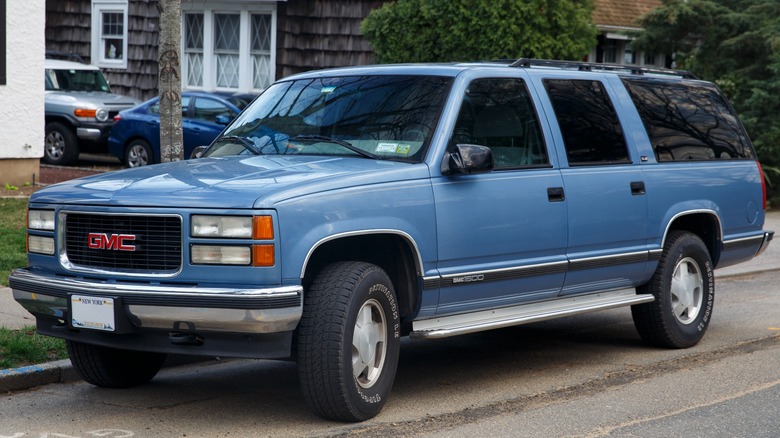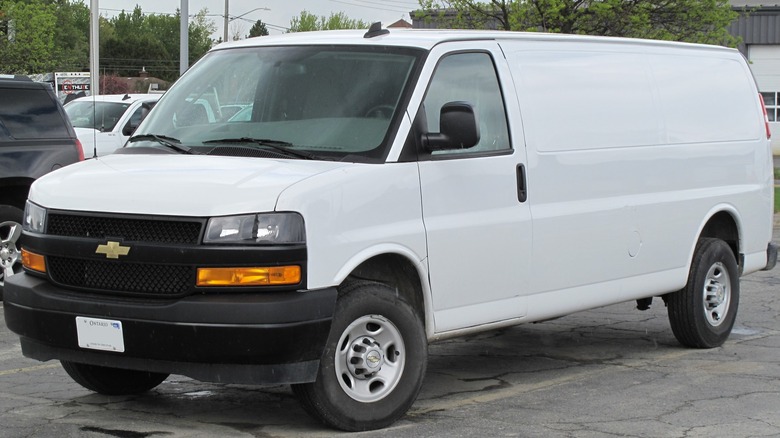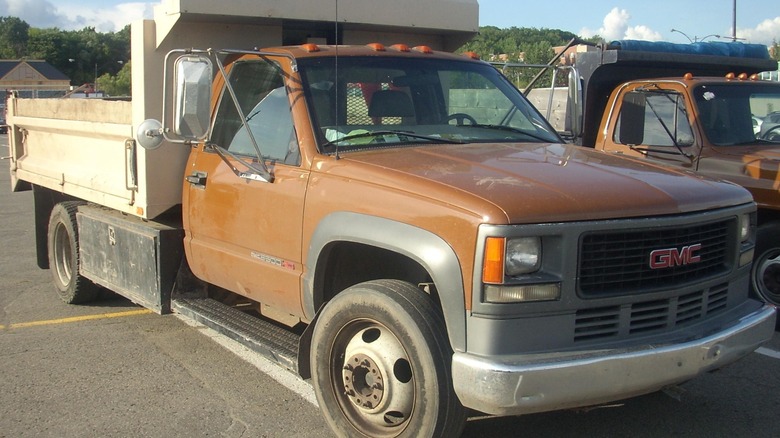Every Chevy And GMC Model Powered By The GM-Detroit Diesel V8 Engine
A car is greater than the sum of its parts. You've got brakes, the frame, the suspension, and a gas tank, to name a few, but the engine is arguably the most important component. This integral element of car design converts fuel into the mechanical force that moves wheels, which in turn moves the car. However, engines are far from universal in design. Electric vehicle engines convert electricity to kinetic motion, but combustion engines, which use combustible fluids such as gasoline and diesel, are far more common.
Cars are veritable chameleons of utility. You can use them to transport yourself or heavy materials, or you can use them to speed around race tracks. However, not every car is ideal for every use, and the engine is a major deciding factor. As such, motor designs vary wildly to provide drivers' desired power, torque, and/or fuel efficiency. Thanks to production methods championed by Henry Ford, many engines are compatible with a bevy of car designs. This rule rings true, especially among combustion engines, regardless of the fuel they take, including diesel.
One of the best, or at least better, diesel engines to hit markets was the GM-Detroit Diesel V8, so here's a list of the Chevy and General Motors Company (GMC) vehicles that relied on the motor.
[Featured image by VX1NG via Wikimedia Commons | Cropped and scaled | CC BY-SA 4.0]
What is the GM-Detroit Diesel V8 Engine?
The pistons and crankshaft of an engine determine the power it can output. For instance, engines that ignite air/fuel mixtures every other full crankshaft rotation (i.e., four-stroke engines) are more powerful than engines that fire every full rotation (two-stroke engines). Additionally, the more pistons an engine has, the more torque it produces, but this comes at the cost of a lower gas economy. V8 engines sit in the goldilocks zone of power and fuel consumption.
The GM-Detroit Diesel V8 Engine was designed to replace the abysmal 1978 Oldsmobile Diesel LF9. As its name suggests, the Detroit Diesel ran on diesel fuel, had eight pistons, and was created by both GMC (back when it was known just as General Motors) and its subsidiary Detroit Diesel. However, the name "V8 Engine" is a misnomer because GMC and Detroit Diesel technically created three Detroit Diesel V8s: a 6.2-liter, a turbocharged 6.5-liter.
While the 6.5-liter versions were upgrades compared to the 6.2-liter one, most of these engines were manufactured during the same years. The 6.2-liter engine could provide anywhere between 130 to 160 horsepower, whereas the 6.5-liter versions managed between 160 and 215 horsepower. Furthermore, GM marketed the 6.5-liter motors as more fuel efficient than their 6.2-liter compatriot, maxing out at 19 mpg.
The Detroit Diesel V8 line lasted from 1982 to 2002, when GM introduced the Duramax V8. However, some U.S. Military High Mobility Multipurpose Wheeled Vehicles (HMMWVs) still rely on Detroit Diesel V8s.
[Featured image by U.S. Naval Forces Central Command via Wikimedia Commons | Cropped and scaled | CC BY 2.0]
1982-1991 Chevrolet/GMC Suburban
The Chevy Suburban is Chevrolet's longest-running line of cars. The company began selling these vehicles in 1935, but then Chevrolet reinvented the Suburban in the 1970s. The car started using the same platforms as Chevy's C/K trucks, and Suburbans began sporting more than two doors. Customers also got their first taste of the GM-Detroit Diesel V8.
While Chevy Suburbans had utilized V8 engines since 1955, they didn't run on diesel until 1982. This generation of Suburbans utilized the original 6.2-liter model of the Detroit Diesel V8, which cranked out 130 horsepower and let the vehicles carry up to 13,500 pounds. While the GM-Detroit Diesel V8 was more fuel efficient than prior diesel engines, drivers could extend their car's driving distance with optional 31 and 40-gallon fuel tanks.
It's worth noting that the GM-Detroit Diesel V8 was introduced in the middle of the Chevy/GMC Suburban's seventh generation, which was already full of gasoline engines, some of which were V8s. To help the new engine slip into the Suburban range, GMC and Detroit Diesel designed their V8 to share existing engines' mounting points and transmission attachments. That way, manufacturing plants didn't need new frames to install the diesel V8s, and customizers could pop and swap Suburbans and engines as they saw fit.
[Featured image by IFCAR via Wikimedia Commons | Cropped and scaled | Public Domain]
1982-1996 Chevrolet/GMC G20 and G30
The Chevrolet G-Series was a decently long-lived line of vans that predated the much more successful Chevrolet Express (more on that later). The company sold the G-Series from 1964 to 1996, and for its final generation, Chevrolet tried to power it with several Detroit Diesel V8s.
Like the Suburban, the Chevy/GMC G-Series vans came with optional V8 engines before Chevrolet started offering the 6.2-liter GM-Detroit Diesel V8. Furthermore, from 1994 to 1996, Chevrolet sold G-Series vehicles with the 6.5-liter model, specifically the naturally aspirated engine. While some Chevrolet cars were built with the turbocharged 6.5-liter V8, the G-series was the only Chevy-branded car line to carry the naturally aspirated Detroit Diesel engines. Moreover, the 6.2-liter GM-Detroit Diesel V8 was the first diesel engine for the G-Series.
As previously stated, Chevrolet didn't sell G-Series vans with GM-Detroit Diesel V8 Engines until the car's final generation, but that was also its longest generation, lasting from 1971 to 1996. This extended lease on life allowed Chevrolet/GMC to use more GM-Detroit Diesel V8 Engine models — and more V8 engines in general — with the G-Series. Eventually Chevrolet retired the G-Series to make way for the Chevrolet Express.
[Featured image by Dennis Elzinga via Wikimedia Commons | Cropped and scaled | CC BY 2.0]
1982-2000 Chevrolet/GMC C/K
Chevrolet's and GMC's C/K badge is mostly associated with pickup trucks. You may know about the C/K line through its current name: Chevy Silverado. Before the C/K was rolled into the Silverado brand permanently, Chevrolet sold a powerful model that channeled the might of the GM-Detroit Diesel V8 Engine.
In 1978, the Chevrolet C/K became the first full-size U.S. pickup with a diesel engine, albeit an Oldsmobile V8. As previously established, this generation of Oldsmobile engines was terrible, so starting in 1982, every vehicle in the C/K line could use the 6.2-liter GM-Detroit Diesel V8, which provided 135 horsepower and 240 lb-ft of torque. In 1992, certain C/K trucks started shipping with the more powerful turbocharged 6.5-liter version. While many C/Ks could be outfitted with the 6.2-liter engines, only C/K trucks with a gross vehicle weight rating (GVWR) of over 8,500 pounds could accept the 6.5-liter V8.
Thankfully, the weight restrictions didn't last long. Until they were reinstated, that is. In 1994, the turbocharged 6.5-liter GM-Detroit Diesel V8 was made available for C/K trucks with a GVWR of under 8,500 pounds. That lasted until 1999. When the Silverado replaced the C/K trucks, the 6.5-liter GM-Detroit Diesel V8 Engines were given one final hurrah as the new line's engines for its first year of life. On a side note, Chevrolet gave the naturally aspirated 6.5-liter engine a limited run in C/K trucks from 1994 to 1995.
[Featured image by MercurySable99 via Wikimedia Commons | Cropped and scaled | CC BY-SA 4.0]
1984-2000 CUCV
Some HMMWVs still use GM-Detroit Diesel V8 Engines. However, these combat cars are manufactured by AM General, the company that also built the original Humvees. Not-so coincidentally, OG Humvees were also powered by Detroit Diesel V8s. These aren't the only military vehicles to use that engine, just the only ones not manufactured by GMC.
The Commercial Utility Cargo Vehicle, or CUCV for short, wasn't a specific vehicle but a program designed to modify civilian trucks for military use. The CUCVs were poorly equipped for actual combat because of civilian origins, but could serve as shelters, ambulances, and mobile command centers and armories. CUCVs utilized a variety of truck chassis, including those from Dodge, Jeep, and GMC, and every company responsible for the modifications used their own engines. GMC did not break this tradition.
Starting in 1984, GMC manufactured CUCVs with existing parts. The company used the 6.2-liter model of the GM-Detroit Diesel V8 for the engine. While these vehicles got 155 horsepower and 240 lb-ft of torque, which vastly outclassed their civilian counterparts, they didn't weather the rigors of battlefields particularly well. GMC's initial run of CUCVs lasted until 1987. Afterwards, they were replaced by a new generation of CUCVs, dubbed CUCV IIs, some of which utilized the superior 6.5-liter Detroit Diesel V8 for a total of 195 horsepower. In 2000, GM said goodbye to the CUCVs, GM-Detroit Diesel V8 Engines and all.
[Featured image by AlfvanBeem via Wikimedia Commons | Cropped and scaled | CC0]
1994-1999 Chevrolet Blazer/Tahoe/GMC Yukon
Full disclosure: badge engineering (more commonly referred to as rebadging) is confusing. Take the Chevrolet Tahoe. This SUV is identical to the GMC Yukon, but before 1994, neither car existed. Instead, Chevrolet sold an SUV known as the Blazer. In 1994, the company split the Blazer line into two paths of different sizes. The smaller SUV was dubbed the "New Blazer," while the larger vehicle, which was the size of a regular Blazer, was renamed the Tahoe. You might never know if you didn't look at the engines.
In 1994, the Blazer, Tahoe, and GMC Yukon all shared the same optional diesel engine: the 6.5L turbocharged GM-Detroit Diesel V8. While the Blazer was discontinued the following year, Chevrolet and GMC still manufactured Tahoes and Yukons with the 6.5L V8 until 1999. These vehicles all had four-wheel drive and two doors (although some sources claim they had three). One year later, the Tahoe and Yukon were upgraded to four-door SUVs, but these versions abandoned the Detroit Diesel V8.
Admittedly, the Tahoe and Yukon continued to use V8 engines after 1999, but these were LS-based small-block engines that ran on gasoline instead of diesel. The Tahoe and Yukon didn't return to diesel until 2021 via the Duramax I6 engine. Perhaps not so coincidentally, the 2021 Tahoe and Yukon are some of the best models in their respective lines.
[Featured image by IFCAR via Wikimedia Commons | Cropped and scaled | Public Domain]
1994-1999 Chevrolet/GMC/Holden Suburban
After the 1991 Chevy Suburban, Chevrolet took a three-year break from putting GM-Detroit Diesel V8 Engines in that vehicle line. After this short siesta, Chevrolet was not only packing in new, upgraded V8s but also exporting the vehicles to foreign countries.
When Chevrolet brought the GM-Detroit Diesel V8 Engine back for 1994's Suburban, the company offered the updated 6.5-liter version instead of the original 6.2-liter engine. This lasted until 1999, when the Suburban line received a generational refresh that did away with diesel engine offerings. In 1998, the Australian car manufacturer Holden imported specially built Suburbans constructed in Mexico for sale in Australia and New Zealand. These vehicles' interior dashboards were mirrored (i.e., the driver sat on the right side instead of the left). However, they still utilized the same 6.5-liter Detroit Diesel V8 motors as their United States counterparts.
After 1999, the Suburban Line underwent a massive rebranding. Up until this point, both GMC and Chevrolet shared the Suburban name, but the Suburban for the new millennium went in two directions. Chevrolet kept the Suburban name, but GMC rolled its Suburbans into its pre-existing line of Yukons. As previously stated, the Yukons dropped diesel V8 engines that year, as did the Suburban SUVs that joined their ranks.
[Featured image by Mr.choppers via Wikimedia Commons | Cropped and scaled | CC BY-SA 3.0]
1996-2002 Chevrolet Express/GMC Savana
The Chevrolet G-Series vans eventually gave way to the Chevy Express, which was rebadged as the GMC Savana. Since the G-20s and G-30s got to have GM-Detroit Diesel V8s under their hoods, it's only fitting that their successors did, too.
Since the 1996 Chevrolet Express' predecessor was built with the turbocharged 6.5-liter Detroit Diesel V8, the company continued using that engine for the Express. And because the Savana was a rebadged copy of the Express, it, too, rocked a turbocharged 6.5-liter V8.
Unlike every other car in this article, the Chevy Express/GMC Savana line consists of a single design generation. The car received a "facelift" in 2003 to alter the front fascia, but aside from that, the Express has remained unchanged, essentially channeling the adage "if it ain't broke, don't fix it." However, that only applied to aesthetics. The Express and Savana lines have been updated numerous times since the facelift, and that initial bit of tantamount botox ended the Express' reliance on the GM-Detroit Diesel V8. From then on, the only diesel engines the Express used were Duramax engines. Aside from those motors, the Express and Savana lines have primarily utilized gasoline-powered V6 and V8 engines.
[Featured image by Elise240SX via Wikimedia Commons | Cropped and scaled | CC BY-SA 4.0]
2001-2002 Chevrolet/GMC C3500HD
Throughout Chevrolet's life, the company has sold newer generations of older vehicle badges alongside their successors. The C/K trucks were one such example, as the final generation, the C3500HD, was sold alongside the Silverado. Chevrolet decided that this line should go out with a diesel-powered V8 bang.
Technically speaking, the C3500HD wasn't a truck but a heavy-duty chassis cab that had previously served as the figurative and literal backbone of the C/K line. The term "chassis cab" isn't a term of art; the C3500HD was a car frame, albeit one that Chevrolet sold with a radiator, transmission, two-wheel drive, and engine options such as the turbocharged 6.5-liter Detroit Diesel V8. It was up to purchasers to turn the chassis into a fully functioning vehicle. Owners could flesh out the C3500HD to create a single cab vehicle – or they could convert it into a four-door or give it four-wheel drive. Regardless of the end result, the chassis had a GVWR of 15,000 pounds.
The C3500HD was a commercial-only product that wasn't available for retail. While the C3500HD chassis had been paired with 6.5-liter Detroit Diesel V8 engines as far back as 1992, that was technically when the frame was part of the C/K line and not a standalone item.
[Featured image by Bull-Doser via Wikimedia Commons | Cropped and scaled | Public Domain]
